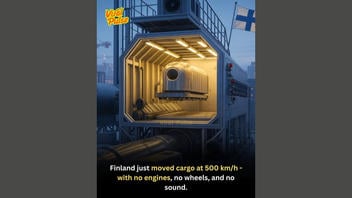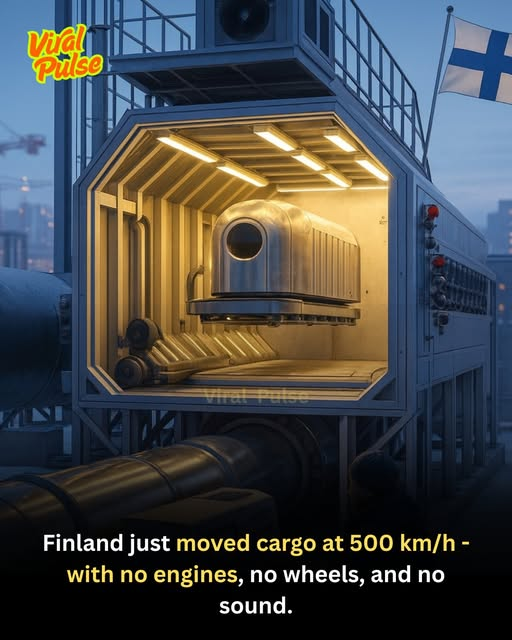
Did Finland test "the world's first engine-less superconducting maglev cargo pipeline, capable of moving cargo at over 500 km/h using no engines, wheels or tracks", as a social media post claimed? No, that's not true: As of August 28, 2025, no media organizations reported on the purported test in Oulu, Finland. The organization that was described as having developed the "sealed vacuum pipeline containing levitating capsules" told Lead Stories those viral posts were "fake news".
The claim appeared in a post (archived here) published on Facebook on August 17, 2025. It read:
Finland has just made global headlines with a futuristic breakthrough in freight transport. In the snowy city of Oulu, engineers have successfully tested the world's first engine-less superconducting maglev cargo pipeline, capable of moving cargo at over 500 km/h using no engines, wheels or tracks.
Developed by the VTT Technical Research Centre of Finland, the system uses a sealed vacuum pipeline containing levitating capsules that glide silently at high speeds. The secret lies in high-temperature superconductors, which, when pre-cooled and placed over a magnetic track, create a locked, frictionless path through magnetic levitation.
This is what the image attached to the post looked like:
(Source: screenshot of an image posted by the Viral Pulse account on Facebook.com)
The post continued:
Instead of engines, the system uses precise air pressure differentials to gently push and slow the capsules. This makes the transport not only fast but incredibly energy-efficient, consuming 80% less energy than current electric trains or aircraft used for freight.
Inside the capsule, cargo is kept in climate-controlled modules, perfect for shipping delicate goods like pharmaceuticals, electronics and perishables. With no moving parts in either the track or the capsule, maintenance is minimal, downtime is reduced and noise is virtually eliminated.
Initial tests on a 10 km prototype track reached stable levitation and speeds of 520 km/h, proving the tech's scalability and efficiency. If expanded nationwide, this could redefine supply chains by offering zero-emission, high-speed delivery with unmatched reliability.
Finland's maglev pipeline could soon become the fastest and quietest cargo transport system on the planet. No fuel. No engines. Just superconductors, magnets and air.
The VTT Technical Research Centre of Finland (archived here) is a real organization, but a search for the keyword "maglev" (archived here) on its website did not yield any results. The website's news section (archived here) didn't show any remotely similar press releases about the purported project.
is unfortunately fake news, which a third party has invented and published.
Searches on Yahoo (archived here) and Google (archived here) across news reports did not produce any matches:
(Source: screenshot of Yahoo.com)
(Source: screenshot of Google.com)
The claim reviewed in this fact check appears to have originated from an August 15, 2025, entry (archived here) on "Cinesign's Blog" that did not have an About page disclosing the entity behind it.
The term "maglev" stands for "magnetic levitation". Despite its name, the technology doesn't place objects high in the air, as shown in the Facebook post's picture. The "levitation" is measured in millimeters, and 1mm is roughly 0.04 inches.
A 2021 Congressional Research Service report (archived here) reads:
Maglev trains use magnetic forces to create a cushion of space between a vehicle and its guideway, reducing friction and permitting top speeds in excess of 300 miles per hour, which are not achievable by conventional wheel-on-rail trains.
The high speeds reached by maglev could theoretically shorten some intercity trips to the length of a local transit ride. Maglev trains can travel roughly 50% faster than the fastest high-speed rail trains currently in use abroad and nearly twice the top speed of Amtrak's Acela, currently the fastest passenger train in the United States. At full speed, maglev trains could offer travel times competitive with airline flights at distances of up to 750 miles.
As of this writing, there are no running maglev trains in the United States. In early August 2025, the White House administration canceled (archived here) federal funding for one of the proposed projects that was intended to shorten the one-hour train commute between Baltimore and Washington, D.C., to 15 minutes.
Examples of functioning maglev projects can be found China (archived here) and Japan (archived here).



















